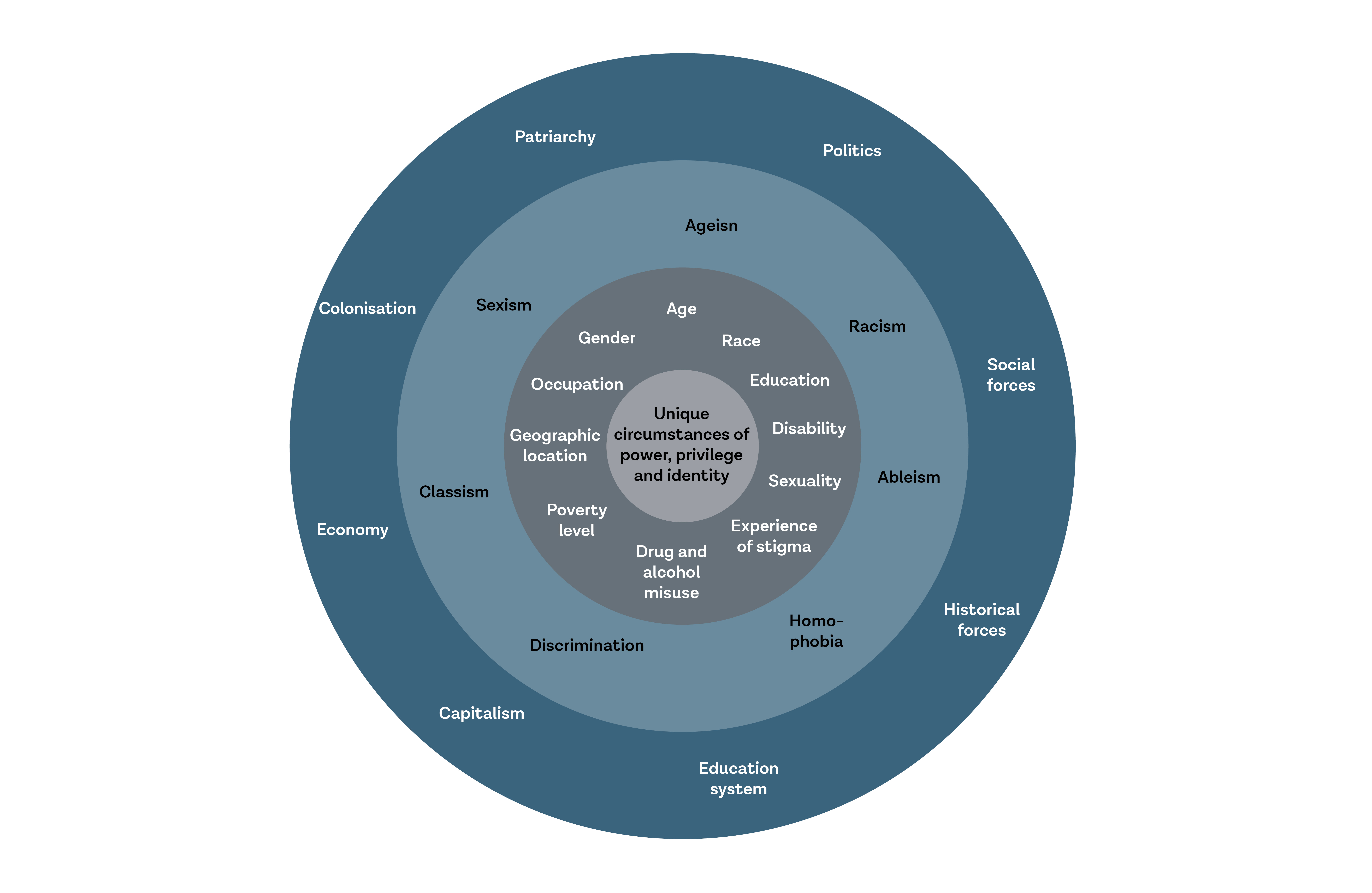Intersectional models
Part of the 'Equity Change Project'
Introduction
In this section we explore in more depth intersectional models and frameworks that help make visible people’s experiences of multiple oppression and discrimination; these include the analogy of the traffic intersection, the Social GRACES model and Intersectional Wheel, and how we use language to perpetuate or challenge power inequalities.
Using the traffic intersection analogy
When we think about the cars crashing into someone, it is really that dramatic.
Change Project participant
Kimberlé Crenshaw, in her TED talk, uses the intersection analogy to describe the experience of someone at a crossroads being hit by multiple vehicles of oppression travelling on different roads of social inequity. As she explains in this talk, the analogy started with the idea that a Black woman standing at an intersection could be hit by vehicles travelling on the roads of sexism and racism. This would cause a collision or interaction of multiple disadvantages and therefore compound disempowerment. It is an analogy we will come back to several times in this resource because it powerfully shows the impact of multiple experiences of oppression.
The intersection analogy can be used as a framework to make visible people’s experiences of multiple discriminations – as in the image below. This is an exercise that we use throughout the resource in different ways to help embed intersectionality.
- Name the roads of inequity that someone stands on.
- Name the vehicles of oppression on the roads.
- Describe the crash.
- Describe the bio-psycho-social injury. (Nayak, 2022)

The intersection analogy.
The crash causes bio-psycho-social harm – that is, harm to all aspects of our wellbeing. The injury or injuries may appear or present like personal issues, such as low self-esteem or mental health difficulties. But it is the context of being positioned on the intersecting roads of social inequity that caused the person to be hit by the vehicles of oppression. This is important because it repositions the cause of the problem away from the person to the context they are in.
As well as the evident impact on wellbeing from significant injuries, Geronimus (2023) points to the ‘weathering’ effect from constant bumps and bruises. These are sometimes referred to as microaggressions – but they are far from micro in their impact. For further discussion of microaggressions, see Speaking up: Challenging microaggressions in the workplace (James-Edwards, 2022).
Reflective question
Reflect on the following quote:
‘The roads of oppression are never quiet, and the number, design and function of the vehicles never cease. Furthermore, these are reckless vehicles bound for collision. Anyone positioned in the intersection will certainly be injured.’ (Nayak, 2022:327).
What are the roads and vehicles in adult social care?
Use the tool below to practice drawing the intersection and identifying the roads, vehicles, crashes and injury.
This tool is a way of drawing intersectional experience and making inequity visible. It can be used in a variety of ways.
The Social Graces model and the Intersectionality Wheel
The Social Graces model (Burnham, 2012) is often used to enable consideration of a person’s identity and the way that different aspects of this might impact on experiences of power, privilege and oppression. Explore the Social Graces model further.

The Social GGRRAAACCEEESSS model.
The Intersectionality Wheel (Simpson, 2009) is similar to the Social Graces model, but the additional circles allow you to see the person’s identity as shaped and impacted by the wider social, cultural and structural context.

The Intersectionality Wheel.
- The innermost circle represents a person’s unique circumstances – the person’s life.
- The second circle represents aspects of identity – how structures impact the person’s life.
- The third circle represents different types of discrimination/isms/attitudes that impact on identity – how these structures start to function.
- The outermost circle represents larger forces and systems that work together to reinforce exclusion – the structures.
This intersectional lens allows us to name specific issues and to locate what is happening in the context rather than with an individual. The elements named on the wheel are not exhaustive. You can add additional areas through discussion and reflection about experiences relating to each circle. The circles are overlapping and create the intersecting experience.
Reflective question
How do I understand the impact of context on people’s identity, including my own?
Use the tool below to to consider how the Intersectionality Wheel and Social Graces can help you explore identity.
This tool helps you to consider how layers of experience and social identities overlap and create someone’s intersecting experience.
The importance of language
You often notice that each service has its own remit and bringing everyone together is hard; people only see their bit; someone has to see the whole picture.
Change Project participant
To increase equity, we need to use the language of social justice. Inequity is perpetuated by differences in power (NHS Health Scotland & Glasgow Centre for Population Health, 2021). Social justice requires us to be clear in the language we use when discussing what is causing harm and the compound impact of this. It also requires us to recognise our biases and how this influences the way we use words.
When we put language under the lens of intersectionality, we think about where the words we use come from and the meanings they carry.
- Who created the language?
- What power did they have?
- How do the words express power?
- How do they impact on people?
An example is the language around hospital discharge. Hospital discharge is fundamentally about ensuring that people, who have needed to be in hospital, are enabled to leave. The language of social justice would focus on the barriers people face and the rights they have to access support to enable them to leave hospital with dignity and their wellbeing promoted. However, language can define people as barriers or impediments, and dehumanise them. For example, the term ‘bed blockers’, widely used in the media, reduces people to one aspect of their lives (their being in a hospital bed) and can create division between them and others.
When thinking about the language we use, it’s important to listen to the voice of lived experience.
- For an individual, this looks like using their own words and preferred ways of identifying themselves in an assessment, for example.
- For services and organisations, co-production of language can be done with groups of experts by experience. This will include acknowledging where there are variations in people’s views and preferences.
An example of co-produced language is the Dementia words matter resource (DEEP, n-d). This sets out words associated with and descriptions of dementia that people living with dementia would prefer are avoided.
Reflective question
Where does the language that you use in your work come from?
Use the tool below to reflect on the importance of language.
This tool helps you to think about how language can be a vehicle of oppression or can be used for liberation.
Example: What does intersectionality mean in adult social care?
We showed Change Project group participants the ‘introduction to intersectionality’ film and talked through the origin and meaning of intersectionality. We explored the intersection analogy, and then we split into small groups to discuss what intersectionality means for our work in adult social care.
Participants told us what intersectionality means to them. They said it means:
- '… looking at and listening to the whole person – where they are, where they’ve been and where they would like to be.'
- '… a way of looking at different aspects of identity that can lead to discrimination and oppression.'
- '… understanding that individuals are more than 'one' element of their identity, and that the multiple layers of identity relate to the unique experiences and discrimination that one may be exposed to.'
- '… how we consider the impact of lived experience on how the person is now and what they may struggle with.'
- '… a way to increase awareness and support new and different ways of thinking with individuals or in wider society.'
We also talked about the vehicles of oppression in adult social care that can injure the adults and carers who come into contact with them. These include:
- misinformation and ignorance
- lack of representation
- stereotypes, prejudices and unconscious bias
- not making reasonable adjustments to enable someone to access the service
- promotion of division – for example, by having services that are only for one aspect of someone’s identity
- disparity in decision-making for people with different characteristics
- lack of challenge when the system doesn’t work for someone
- lack of action when concerns are raised.